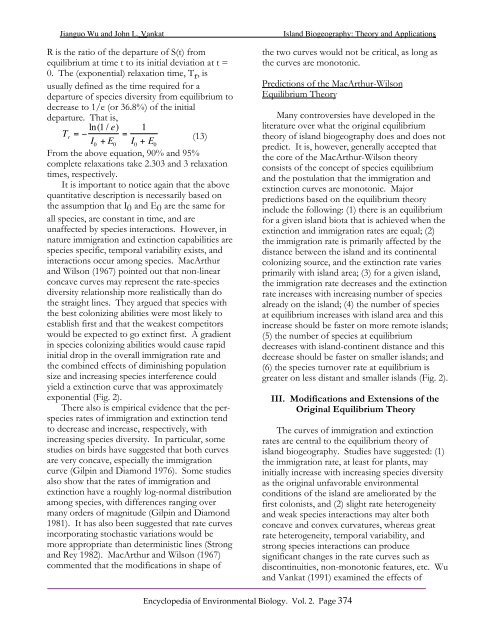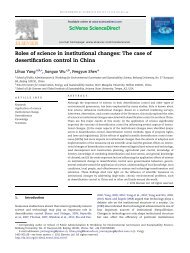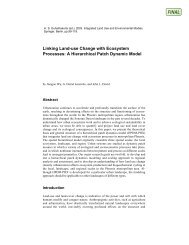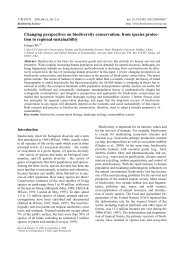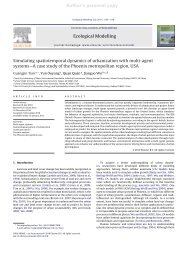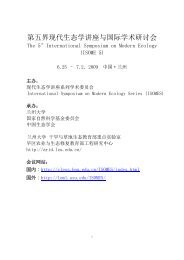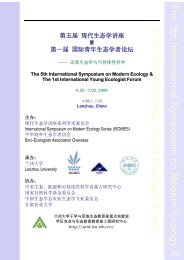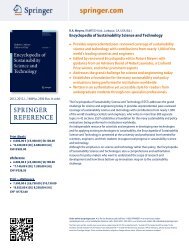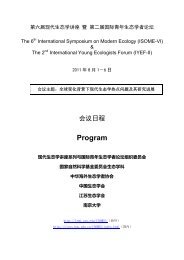Wu, J. and J. L. Vankat. 1995. Island biogeography: theory and ...
Wu, J. and J. L. Vankat. 1995. Island biogeography: theory and ...
Wu, J. and J. L. Vankat. 1995. Island biogeography: theory and ...
You also want an ePaper? Increase the reach of your titles
YUMPU automatically turns print PDFs into web optimized ePapers that Google loves.
Jianguo <strong>Wu</strong> <strong>and</strong> John L. <strong>Vankat</strong> Isl<strong>and</strong> Biogeography: Theory <strong>and</strong> Applications<br />
R is the ratio of the departure of S(t) from<br />
equilibrium at time t to its initial deviation at t =<br />
0. The (exponential) relaxation time, Tr , is<br />
usually defined as the time required for a<br />
departure of species diversity from equilibrium to<br />
decrease to 1/e (or 36.8%) of the initial<br />
departure. That is,<br />
ln(1 / e) 1<br />
Tr = - =<br />
(13)<br />
I 0 + E 0<br />
I 0 + E 0<br />
From the above equation, 90% <strong>and</strong> 95%<br />
complete relaxations take 2.303 <strong>and</strong> 3 relaxation<br />
times, respectively.<br />
It is important to notice again that the above<br />
quantitative description is necessarily based on<br />
the assumption that I 0 <strong>and</strong> E 0 are the same for<br />
all species, are constant in time, <strong>and</strong> are<br />
unaffected by species interactions. However, in<br />
nature immigration <strong>and</strong> extinction capabilities are<br />
species specific, temporal variability exists, <strong>and</strong><br />
interactions occur among species. MacArthur<br />
<strong>and</strong> Wilson (1967) pointed out that non-linear<br />
concave curves may represent the rate-species<br />
diversity relationship more realistically than do<br />
the straight lines. They argued that species with<br />
the best colonizing abilities were most likely to<br />
establish first <strong>and</strong> that the weakest competitors<br />
would be expected to go extinct first. A gradient<br />
in species colonizing abilities would cause rapid<br />
initial drop in the overall immigration rate <strong>and</strong><br />
the combined effects of diminishing population<br />
size <strong>and</strong> increasing species interference could<br />
yield a extinction curve that was approximately<br />
exponential (Fig. 2).<br />
There also is empirical evidence that the perspecies<br />
rates of immigration <strong>and</strong> extinction tend<br />
to decrease <strong>and</strong> increase, respectively, with<br />
increasing species diversity. In particular, some<br />
studies on birds have suggested that both curves<br />
are very concave, especially the immigration<br />
curve (Gilpin <strong>and</strong> Diamond 1976). Some studies<br />
also show that the rates of immigration <strong>and</strong><br />
extinction have a roughly log-normal distribution<br />
among species, with differences ranging over<br />
many orders of magnitude (Gilpin <strong>and</strong> Diamond<br />
1981). It has also been suggested that rate curves<br />
incorporating stochastic variations would be<br />
more appropriate than deterministic lines (Strong<br />
<strong>and</strong> Rey 1982). MacArthur <strong>and</strong> Wilson (1967)<br />
commented that the modifications in shape of<br />
the two curves would not be critical, as long as<br />
the curves are monotonic.<br />
Predictions of the MacArthur-Wilson<br />
Equilibrium Theory<br />
Encyclopedia of Environmental Biology. Vol. 2. Page 374<br />
Many controversies have developed in the<br />
literature over what the original equilibrium<br />
<strong>theory</strong> of isl<strong>and</strong> <strong>biogeography</strong> does <strong>and</strong> does not<br />
predict. It is, however, generally accepted that<br />
the core of the MacArthur-Wilson <strong>theory</strong><br />
consists of the concept of species equilibrium<br />
<strong>and</strong> the postulation that the immigration <strong>and</strong><br />
extinction curves are monotonic. Major<br />
predictions based on the equilibrium <strong>theory</strong><br />
include the following: (1) there is an equilibrium<br />
for a given isl<strong>and</strong> biota that is achieved when the<br />
extinction <strong>and</strong> immigration rates are equal; (2)<br />
the immigration rate is primarily affected by the<br />
distance between the isl<strong>and</strong> <strong>and</strong> its continental<br />
colonizing source, <strong>and</strong> the extinction rate varies<br />
primarily with isl<strong>and</strong> area; (3) for a given isl<strong>and</strong>,<br />
the immigration rate decreases <strong>and</strong> the extinction<br />
rate increases with increasing number of species<br />
already on the isl<strong>and</strong>; (4) the number of species<br />
at equilibrium increases with isl<strong>and</strong> area <strong>and</strong> this<br />
increase should be faster on more remote isl<strong>and</strong>s;<br />
(5) the number of species at equilibrium<br />
decreases with isl<strong>and</strong>-continent distance <strong>and</strong> this<br />
decrease should be faster on smaller isl<strong>and</strong>s; <strong>and</strong><br />
(6) the species turnover rate at equilibrium is<br />
greater on less distant <strong>and</strong> smaller isl<strong>and</strong>s (Fig. 2).<br />
III. Modifications <strong>and</strong> Extensions of the<br />
Original Equilibrium Theory<br />
The curves of immigration <strong>and</strong> extinction<br />
rates are central to the equilibrium <strong>theory</strong> of<br />
isl<strong>and</strong> <strong>biogeography</strong>. Studies have suggested: (1)<br />
the immigration rate, at least for plants, may<br />
initially increase with increasing species diversity<br />
as the original unfavorable environmental<br />
conditions of the isl<strong>and</strong> are ameliorated by the<br />
first colonists, <strong>and</strong> (2) slight rate heterogeneity<br />
<strong>and</strong> weak species interactions may alter both<br />
concave <strong>and</strong> convex curvatures, whereas great<br />
rate heterogeneity, temporal variability, <strong>and</strong><br />
strong species interactions can produce<br />
significant changes in the rate curves such as<br />
discontinuities, non-monotonic features, etc. <strong>Wu</strong><br />
<strong>and</strong> <strong>Vankat</strong> (1991) examined the effects of


